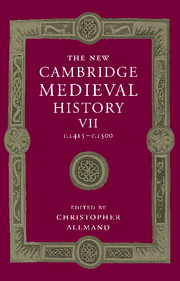Book contents
- Frontmatter
- PART I GOVERNMENT
- PART II ECONOMIC AND SOCIAL DEVELOPMENTS
- PART III SPIRITUAL, CULTURAL AND ARTISTIC LIFE
- PART IV THE DEVELOPMENT OF EUROPEAN STATES
- 17 Germany and the Empire
- 18 Hus, the Hussites and Bohemia
- 19 France
- 20 Burgundy
- 21 England
- 22 The Celtic world
- 23 Italy
- 24 The Iberian peninsula
- (a) Aragon
- (b) Castile and Navarre
- (c) Portugal
- 25 The Swiss Confederation
- 26 The States of Scandinavia, c. 1390– c. 1536
- 27 Hungary: Crown and Estates
- 28 The Kingdom of Poland and the Grand Duchy of Lithuania, 1370–1506
- 29 Russia
- 30 Byzantium: The Roman Orthodox World, 1393–1492
- 31 The Latin East
- 32 The Ottoman World
- 33 Conclusion
- Appendix Genealogical Tables
- Primary Sources and Secondary Works Arranged by Chapter
- Index
- Frontispiece
- Plate section
- Map 1 European towns in the late Middle Ages
- Map 2 European commerce and trade
- Map 4 Winds and currents facilitating the discoveries
- Map 5 The universities o f Europe in 1400 and 1500
- Map 6 Germany and the Empire
- Map 20 The Roman Orthodox and Ottoman worlds in the fifteenth century
- References
(c) - Portugal
from 24 - The Iberian peninsula
Published online by Cambridge University Press: 28 March 2008
- Frontmatter
- PART I GOVERNMENT
- PART II ECONOMIC AND SOCIAL DEVELOPMENTS
- PART III SPIRITUAL, CULTURAL AND ARTISTIC LIFE
- PART IV THE DEVELOPMENT OF EUROPEAN STATES
- 17 Germany and the Empire
- 18 Hus, the Hussites and Bohemia
- 19 France
- 20 Burgundy
- 21 England
- 22 The Celtic world
- 23 Italy
- 24 The Iberian peninsula
- (a) Aragon
- (b) Castile and Navarre
- (c) Portugal
- 25 The Swiss Confederation
- 26 The States of Scandinavia, c. 1390– c. 1536
- 27 Hungary: Crown and Estates
- 28 The Kingdom of Poland and the Grand Duchy of Lithuania, 1370–1506
- 29 Russia
- 30 Byzantium: The Roman Orthodox World, 1393–1492
- 31 The Latin East
- 32 The Ottoman World
- 33 Conclusion
- Appendix Genealogical Tables
- Primary Sources and Secondary Works Arranged by Chapter
- Index
- Frontispiece
- Plate section
- Map 1 European towns in the late Middle Ages
- Map 2 European commerce and trade
- Map 4 Winds and currents facilitating the discoveries
- Map 5 The universities o f Europe in 1400 and 1500
- Map 6 Germany and the Empire
- Map 20 The Roman Orthodox and Ottoman worlds in the fifteenth century
- References
Summary
portugal comprises two large and very distinct geographical zones, a mountainous one in the north, a lowland one in the south, the dividing line being the river Tagus. From a climatic point of view, the country displays elements of both the Atlantic seaboard and the Mediterranean: high levels of rainfall in the northern regions and striking dryness in the south. Five rivers act as gateways to the ocean and the outside world: the Douro and Tagus, whose sources lie in Spain, and the Vouga, Mondego and Sado which rise in Portugal itself. The principal urban centres, Coimbra, Lisbon, Oporto and Silves, were riverside communities, as were many lesser settlements with a history of fishing, shipbuilding and maritime enterprise. Several inland towns acted as seats of bishoprics and as centres of administration, agriculture, manufacture and commerce.
The north had always been more highly populated than the south, and it was the northern region of Entre-Douro-e-Minho which had provided the population which had moved southwards in the twelfth and thirteenth centuries as the Moors were driven out. Later, in the fifteenth and sixteenth centuries, after the discovery of the Atlantic islands and Brazil, it was still from the same region that the largest numbers of settlers came. In the fourteenth century, on the eve of the Black Death, the population of Portugal probably stood at about 1.5 million, at a reasonable European average of some seventeen inhabitants per square kilometre. In 1348, however, this figure fell between a third and a half, at which level it was maintained, with slight modifications, until about 1460, when a recovery began. By the first quarter of the sixteenth century, the pre-Black Death figure had been restored.
- Type
- Chapter
- Information
- The New Cambridge Medieval History , pp. 627 - 644Publisher: Cambridge University PressPrint publication year: 1998



